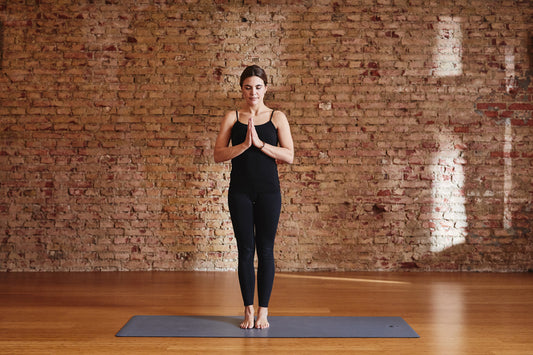
Set-Offers
Save when you buy a set
Shopping cart
Your shopping basket is empty
Yoga

Meditation
Bundles

| Wissen & Wirkung
They are the three magical syllables that end every yoga session: Namasté. But what does this lovely word literally mean? What is the so-called third eye, and why is it necessary to bow your head when you say Namasté? Discover everything you need to know about this salutation right here!

Like all an experienced yogi’s words in their yoga glossary, "namasté" comes from the Indian Sanskrit. The term is composed of the syllables nama (bow), as (I) and té (you). Namasté can therefore be translated as "bowing to you" or "I bow to you". This expresses reverence and acknowledges the presence of the other person with gratitude.
Among Western practitioners, the word namasté is frequently spoken aloud. But in fact, "Namasté" can also be expressed only through gestures, namely through Anjali Mudra. In Hinduism, this gesture is shared as a form of greeting, much like shaking hands.
Anjali Mudra consists of placing the palms of the hands together in front of the chest or, to stay with the yoga vernacular, the heart chakra. Incidentally, this has nothing to do with a religious prayer posture but is meant to give you energy, as the gesture unites both hemispheres of the brain. Namasté is then expressed by tilting your head towards the heart with your eyes closed, i.e., making an implied bow.
This greeting probably sounds familiar to you. There is another variation that conveys especially great respect. In the Anjali Mudra, the tips of the two index fingers touch the area between the eyes while the head is lowered. According to yoga teachings, this is the location of the third eye, the energy centre.

Theoretically, there are many situations in which it is appropriate to say namasté; after all, it is a gesture of respect. In yoga, the greeting is usually at the beginning and end of the practice. With a consciously performed namasté, teacher and student thank each other and express recognising in each other a unity that connects everything.
If you have ever done yoga, you know the wonderful feeling of calm that comes during the practice. Namasté expresses, in a nutshell, everything that yoga brings about: Gratitude, self-love, finding and maintaining your energy, respect and mindfulness - a small word with meaningful content. In this sense: Namasté!
Find more exciting definitions under our blog category 'Knowledge & Effect'!

Playful and curious yogis love the relatively young style: Acroyoga is trending! In acrobatic yoga, asanas are combined with playful elements and t...
Continue reading
90 minutes, a hot room, 26 exercises: This is the mix that defines Bikram Yoga. The style is named after its founder Bikram Choudhury, but is also...
Continue reading
There are no comments yet. Be the first to leave a comment!